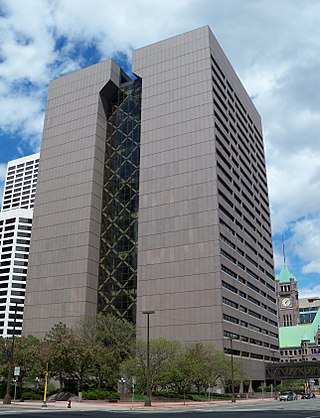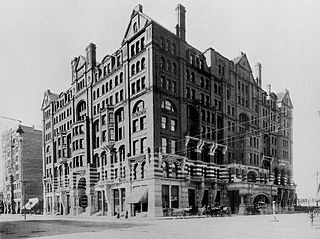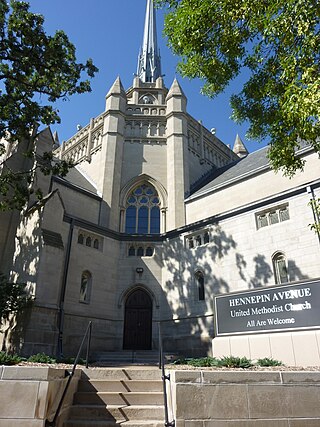


The Hennepin County Law Library is a law library located in Minneapolis, Minnesota, founded in 1883.



The Hennepin County Law Library is a law library located in Minneapolis, Minnesota, founded in 1883.
The Hennepin County Law Library is organized under Chapter 134A [1] of the Minnesota Statutes. The governing agency is a seven-member Board of Trustees consisting of three judges of the Fourth Judicial District, three practicing attorneys, and a member of the Hennepin County Board of Commissioners. [2] The library, which is open to the public, is funded by a combination of court fees, user fees, and an appropriation from the Hennepin County general revenue fund.
The Hennepin County Law Library had its origin when the Minneapolis Bar Association incorporated on February 20, 1883. The Bar Association was a stock corporation that allowed members to pay for stock by contributing books, the value of which was determined by an appraisal committee. The law library's first location was a room on the second floor of a building on Nicollet Avenue adjoining the First National Bank at Washington Avenue. In August 1883 the collection was moved to the Academy of Music Building, at the corner of Washington and Hennepin Avenues. This magnificent building, a showplace for the arts and the center of the city's entertainment district, was gutted by fire on Christmas Day, 1884. The law library was completely destroyed. With the insurance proceeds of $15,000, the Bar Association began rebuilding the law library, which opened in the Boston Block on May 1, 1885. This was another famous building that boasted the first indoor court in Minneapolis. But in April 1886, it was also struck by fire, destroying the law library for a second time. With the insurance of $20,000, a third law library was established in the Temple Court building, which occupied the site of the former Academy of Music Building. By 1895 the law library contained about 7,000 volumes. In 1903 it was provided accommodations in Room 434 of the new Court House and City Hall building. In 1960 the law library moved to Room 318, where it remained until its move in September 1976 to its present location in the Hennepin County Government Center.
The law library is named for Anne W. Grande, who served as law librarian for 33 years, from 1975 to 2008.
The law library was renovated in the summer of 2016.
According to a 1941 Hennepin Lawyer article by Thomas Kneeland, one of the incorporators of the Minneapolis Bar Association, the Bar Association employed three librarians during the time it owned the law library. Kneeland listed the first as Edward S. Waters, though a newspaper article on December 26, 1884 in the Minneapolis Evening Journal stated that F. S. Gaylord was the librarian at the time of the Christmas Day fire. The History of the Bench and Bar of Minnesota, by Hiram F. Stevens (Minneapolis: Legal Publishing and Engraving Co., 1904) lists E.S. Waters as Treasurer of the Minneapolis Bar Association in 1904. Kneeland listed the second librarian as Frederic Klapp, who was succeeded in 1921 by his son, S. D. Kapp, who served until his death in 1937. Hennepin County law librarians include Lillian W. Taylor (1937–1944), Buelah C. Blaisdell (1944–1948), Ethel Kommes (1948–1975), Anne Grande (1975–2008), Ed Carroll (2008–2015), Karen Westwood (2015–current). [3]

Hennepin County is a county in the U.S. state of Minnesota. Its county seat is Minneapolis, the state's most populous city. The county is named in honor of the 17th-century explorer Father Louis Hennepin. The county extends from Minneapolis to the suburbs and outlying cities in the western part of the county. The county’s natural areas are covered with extensive woods, hills, and lakes.

William Smith King was a Republican U.S. Representative for Minnesota from March 4, 1875 to March 3, 1877. He was a journalist and businessman. He is best known for allegations of political corruption during this congressional term. The House of Representatives did not specify his offense, but decided it was constitutionally unable to punish him for actions that took place before he entered Congress. He did not run for reelection.

The Minneapolis Public Library (MPL) was a library system that served the residents of Minneapolis, Minnesota in the United States. It was founded in 1885 with the establishment of the Minneapolis Library Board by an amendment to the Minneapolis City Charter. Lumber baron and philanthropist T. B. Walker and other city leaders such as Thomas Lowry were members of the first library board. In 2008, after some financial difficulties, the library was merged into the Hennepin County Library system. At the time of its merger, the library included Central Library in downtown Minneapolis and fourteen branch libraries. Its collection numbered about 3.1 million items with about 2.2 million of these housed in the central library.

Opened in 1884, the West Hotel was Minneapolis's first grand hotel. It had 407 luxuriously furnished rooms, 140 baths, and featured an immense and opulent lobby which was claimed to be the largest in the nation. These elements combined to make what was considered for a time to be the most luxurious hotel west of Chicago. The West was designed by LeRoy Buffington and built on land that was once owned by the first resident of Minneapolis, John H. Stevens. Buffington created the West in the Queen Anne style that was quite popular in the last decades of the 19th century.

Lowry Hill East is a neighborhood in southwest Minneapolis, Minnesota, United States, part of the Calhoun Isles community. Lowry Hill East developed in the 1880s along a horse-drawn streetcar line built by Thomas Lowry. The interior of the neighborhood is residential, with large early 20th century homes and multi-unit apartment buildings, while the border streets are lined with bars, restaurants, grocery stores, coffeeshops, and other small businesses. Most housing is renter-occupied.

The Federal Reserve Bank of Minneapolis, located in Minneapolis, Minnesota, in the United States, covers the 9th District of the Federal Reserve, which is made up of Minnesota, Montana, North and South Dakota, northwestern Wisconsin, and the Upper Peninsula of Michigan. Although its geographical territory is the third largest of the 12 Federal Reserve banks, it serves the smallest population base of the system. It has one branch, which is in Helena, Montana.
Richard John Baker v. Gerald R. Nelson, 291 Minn. 310, 191 N.W.2d 185 (1971), was a case in which the Minnesota Supreme Court decided that construing a marriage statute to restrict marriage licenses to persons of the opposite sex "does not offend" the U.S. Constitution. Baker appealed the decision, and on October 10, 1972, the U.S. Supreme Court dismissed the appeal "for want of a substantial federal question".

The Pence Opera House was an opera house and later, a mission, at Hennepin Avenue and 2nd Street in Minneapolis, Minnesota, United States.

Stadium Village is an area of Minneapolis, Minnesota near the East Bank campus of the University of Minnesota. While not an official neighborhood of Minneapolis, the area is an important commercial district that serves university students with many bars and restaurants. There are plans to incorporate it into an official neighborhood of Minneapolis along with the surrounding area. It is part of Southeast Minneapolis, that part of Minneapolis on the East Bank of the Mississippi River and south of Hennepin Avenue

Downtown West is an official neighborhood in Minneapolis, part of the larger Central community. It is the heart of downtown Minneapolis, containing the bulk of high-rise office buildings in the city, and is what comes to mind when most Minneapolitans think of "downtown".

The Gateway District of Minneapolis is centered at the convergence of Hennepin Avenue, Nicollet Avenue, and Washington Avenue. Its borders are not officially designated or recognized, but are visible as the Mississippi River to the northeast, Cedar Lake Trail and the railroad tracks to the northwest, Fifth Avenue South to the southeast. and Fourth Street South to the southwest. The district includes a significant part of the Downtown West neighborhood and abuts the North Loop.

Lynnhurst is a neighborhood in the Southwest community in Minneapolis, Minnesota. Its boundaries are 46th Street to the north, Lyndale Avenue to the east, 54th Street to the south, and Penn Avenue to the west. It is located along the southeastern shore of Lake Harriet. Outflows from the lake run through a parkway for several city blocks to reach Minnehaha Creek.

Sumner Library is a neighborhood library located in the Near-north neighborhood of Minneapolis, Minnesota, United States. Originally part of the Minneapolis Public Library, it became part of the merged Hennepin County Library in 2008. The Carnegie Library was a haven for Jewish immigrants to the city in the early 20th century. The Minneapolis Public Library moved its entire collection of Yiddish and Hebrew works to the branch library in response to a survey showing that 95% of the patrons were Jewish immigrants, some of whom learned English there and participated in social clubs in the building. The Tudor Revival building is listed on the National Register of Historic Places.

Walker Library is a public library in the East Isles neighborhood of Minneapolis, Minnesota, United States. It is on Hennepin Avenue one block north of Lake Street, adjoining the Midtown Greenway.

Hennepin Avenue United Methodist Church is a church across the Virginia Triangle from the Walker Art Center in Minneapolis, Minnesota. Its address is 511 Groveland Avenue.

Minneapolis Central Library, a library in downtown Minneapolis, Minnesota, United States, is the largest library of the Hennepin County Library public library system. It bills itself as having "the third largest per capita public library collection of any major city in America with a collection of more than 2.4 million items—including books, DVDs, music, government documents." The 353,000-square-foot (32,800 m2) building at 300 Nicollet Mall with two levels of underground parking was designed by César Pelli and opened on May 20, 2006. It has over 300 computers for use by the public, an 8,140-square-foot (756 m2) atrium, an 18,560-square-foot (1,724 m2) green roof planted with low-growing ground cover designed to "be sun- and drought-resistant", and a host of energy-efficiency measures.

Library service to the Hopkins, Minnesota community was established more than 100 years ago, when the library was housed in City Hall. The library moved to the historic Dow House in 1948 and then temporarily to a vacant restaurant in 1963. The library opened in its current location in 1968 and was renovated in 2002. The library joined Hennepin County Library in 1973.
Augsburg Park Library is a public library in Richfield, Minnesota. A Richfield branch library of Hennepin County Library has existed in various buildings in since 1951.

Edina Library is a branch of Hennepin County Library serving Edina, Minnesota, United States.
Coordinates: 44°58′33″N93°15′59″W / 44.975848°N 93.266339°W